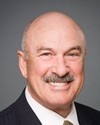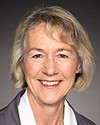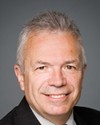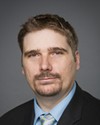Thank you very much, sir.
Mr. Chairman and members of the committee, my fellow officers and I are very pleased to have the opportunity to talk to you about caring for our own programs—much that you've heard over your adjudications in the last while—and specifically, the care of our ill and injured Canadian armed forces personnel and their families.
I'm very delighted today to have family members from the Canadian Forces and family members from our veterans here with us today. I was speaking with Claude and Jenny as well as Paula, and it's wonderful to hear some of the words and the praises that we have for them as we help our military members get back onto their feet, back into the Canadian Forces, or to transition from our hands to our communities and into the hands of Veterans Affairs.
Joining me, as the chair indicated, is Scott McLeod, my director of mental health, and Rakesh Jetly, my chief psychiatrist for the Canadian armed forces.
When Canadian armed forces members are seriously injured or suffer an illness to the extent that they cannot function in their regular duties, they are admitted into the care of our own program consisting of three phases, as you've heard from Colonel Blais: recovery, rehabilitation, and reintegration. Administered by our 24 integrated personnel support centres across the country, such as Petawawa, which you visited recently, the program is compassionate, tailored to the members' needs, and has no set timeline, as recovery from an injury or illness does not have a schedule. It's a perfect marriage: the IPSCs provide the valuable administrative support while our Canadian Forces health system provides the care.
In some individual cases, the road to recovery is measured in months, where at the request of the member, because of a job opportunity from outside of the military, the process only takes six months. However, more typically, the road to recovery, rehabilitation, and reintegration is measured in years, from the point of injury to when our members no longer need our help. Members like Corporal Glen Kirkland, a budding real estate agent, and Master Corporal Jody Mitic, of Amazing Race fame, are for me the ambassadors of our program as they epitomize how, through their will and determination, combined with the care and comfort that we provide, anyone can overcome injury and illness and move on in life to do amazing things.
Let me briefly describe our programs. Recovery and rehabilitation phases are mostly in the hands of our medical experts who lead in the fields of physical and mental recovery and rehabilitation. Our seven operational trauma stress support centres, such as the one here in Ottawa; our state-of-the-art rehabilitation equipment and centres of excellence; our extensive military health research program, along with our many external partners such as Veterans Affairs, with its 10 operational stress injury centres; the Royal Ottawa Mental Health Centre, which we partner with; and the Canadian Institute for Military and Veteran Health Research form this tremendous network of care and support.
The reintegration phase becomes a shared responsibility among the members, our medical staff, and the chain of command. Reintegration may entail working part-time with another military unit or going back to school for academic upgrading, or it could perhaps be working at Royal LePage real estate in order to acquire an operating license, or it could be working with The Royal Canadian Legion, with Canada Company, or with another government department, all the while receiving a military salary.
One of the purposes of reintegration is to re-instill confidence, self-esteem, and a sense of pride and self-worth, which are key ingredients for military warriors on the road to recovery. Working outside the Canadian armed forces is often more conducive to recovery as working in the military can sometimes be contributory to the ailment. Often members will find a new niche, a new vocation, and actively release to pursue a new beginning outside of the military. For those transitioning out of our care and into the hands of Veterans Affairs, we offer vocational rehabilitation in the form of on-the-job training and an educational upgrade program.
Our latest initiative is the military employment transition program led by Canada Company, where up to 200 employers are offering jobs to our veterans through the “1,000 jobs in 10 years” campaign. Our new military employment transition program features career assessment, market analysis, resumé writing, job search, job coaching, and job mentoring. Currently, there are more jobs than applicants, but this is because we're at the leading edge of the program.
Thanks to the True Patriot Love Foundation and its research into employers' tendency to hire veterans, and thanks to leading companies like Prospect Human Services—which has an 85% success rate in finding jobs for veterans from the Edmonton area—we have set up a single-window job access capability to assist our veterans and mitigate their concerns at the prospect of starting a new career.
For members transitioning into the community and planning to seek outside employment, Veterans Affairs Canada and Department of National Defence staff start working together six months before the member's release.
For veterans who are leaving and have complex needs, an integrated transition plan is prepared—a task that includes the member and all relevant personnel. The plan sees to it that the member's needs relating to medical care, education, future employment and Veterans Affairs Canada support are met.
Once this process is completed, the member either signs the plan, indicating their agreement, or states that the plan is inadequate. There have been few cases in the past where members have disagreed with the plan, but in such cases, the plan undergoes a review to mitigate the member's concerns.
The focal point for this entire effort is the joint personnel support unit, of which there are 24 integrated personnel support centres across Canada employing 97 civilians and 179 military staff, housing families, spiritual, social, and financial support specialists along with our Canadian Forces health services managers and Veterans Affairs Canada staff in location. This collaboration has greatly facilitated the comprehensive care for our members and their families. You undoubtedly witnessed the care and the compassion of those who work at the IPSC when you visited Petawawa.
The program has been successful at demystifying the stigma associated with getting help. Today, we have 1,924 members assigned to the joint personnel support unit across Canada. Of these, 60% can have some form of mental illness ranging from PTSD to depression and varying forms of anxiety associated with the rigours of military life in general. The fact that our numbers are increasing is indicative that the barriers are coming down slowly, but more needs to be done.
You will have read that we recently lost soldiers to suicide. Our suicide prevention program, our education and awareness, the resiliency training, the screening, our outreach, and research are all a part of our mental health strategy. Although our suicide rate is lower than in the rest of Canadian society, although our rate has not increased since 1995 despite our heavy commitment in Afghanistan, although 2013 was one of the lower rates in years, although those in need can get immediate mental health care from a medical officer, and although we have first-rate mental illness facilities, resources and support, and the best mental health practitioner ratio to service population in NATO, we can do more.
A significant percentage of those who do commit suicide appear not to have a diagnosed mental disorder and were likely suffering in silence. The most prevalent barrier to care is that most of us with mental disorders do not appear to recognize that we have a problem. This barrier is seen in almost 90% of those who have an apparent disorder. The next most prevalent barrier is the desire to manage one's problems on one's own, being stoic and proud. Impacts on career and negative attitudes towards mental health are also common.
The key to success in dealing with mental illness is early intervention. To help our members, we need to accentuate the positives because every time we give the perception that we are criticizing the outstanding work being done by our JPSU and our health services, the less likely it is that those on the fence will come for help.
We need to balance the narrative with stories such as Mr. Sneddon's. Corporal Moe Sneddon's father called the JPSU in Halifax following his son's suicide to say that his son's death had nothing to do with his PTSD but was related to other cause factors. He said that in the note his son left, Corporal Sneddon asked the staff at the JPSU in Halifax to be thanked for their help, as he would not have survived as long as he did without them.
From our suicide investigations, roughly 60% of personnel have deployed, whereas 40% have not. Of the cause factors, the most prevalent triggers are 45% relationship-related, 21% disciplinary career problems, 16% financial, and 10% legal.
De-stigmatizing mental illness, addressing psychosocial factors, greater education and awareness, and building resilience are my areas of focus as we strive to better understand the complexities behind mental illness and enhance our programs to support our men and women and their families.
Regrettably, time does not permit me to describe the various programs. However, we have provided copies of “Caring for Our Own”, our “Mental Health Strategy”, the road to mental readiness pamphlet, our morale and welfare services pamphlet, our comprehensive aide-memoire and benefits, and the programs and services of the Canadian armed forces and Veterans Affairs.
You've heard about Soldier On, the Injured Soldier Network, home modification, vehicle modification, and all of the other benefits. We can address some of those during our question and answer period.
Mr. Chair, thank you very much.









